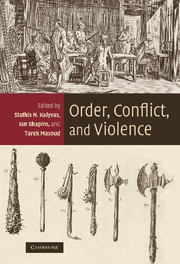Book contents
- Frontmatter
- Contents
- List of figures
- List of tables
- List of contributors
- Preface
- 1 Introduction: integrating the study of order, conflict, and violence
- Part 1 Creating, maintaining, and restoring order
- Part 2 Challenging, transforming, and destroying order
- 8 Civil wars and guerrilla warfare in the contemporary world: toward a joint theory of motivations and opportunities
- 9 Clausewitz vindicated? Economics and politics in the Colombian war
- 10 Articulating the geo-cultural logic of nationalist insurgency
- 11 Which group identities lead to most violence? Evidence from India
- 12 Order in disorder: a micro-comparative study of genocidal dynamics in Rwanda
- 13 Sexual violence during war: toward an understanding of variation
- 14 “Military necessity” and the laws of war in Imperial Germany
- 15 Preconditions of international normative change: implications for order and violence
- 16 Promises and pitfalls of an emerging research program: the microdynamics of civil war
- Index
- References
11 - Which group identities lead to most violence? Evidence from India
Published online by Cambridge University Press: 06 July 2010
- Frontmatter
- Contents
- List of figures
- List of tables
- List of contributors
- Preface
- 1 Introduction: integrating the study of order, conflict, and violence
- Part 1 Creating, maintaining, and restoring order
- Part 2 Challenging, transforming, and destroying order
- 8 Civil wars and guerrilla warfare in the contemporary world: toward a joint theory of motivations and opportunities
- 9 Clausewitz vindicated? Economics and politics in the Colombian war
- 10 Articulating the geo-cultural logic of nationalist insurgency
- 11 Which group identities lead to most violence? Evidence from India
- 12 Order in disorder: a micro-comparative study of genocidal dynamics in Rwanda
- 13 Sexual violence during war: toward an understanding of variation
- 14 “Military necessity” and the laws of war in Imperial Germany
- 15 Preconditions of international normative change: implications for order and violence
- 16 Promises and pitfalls of an emerging research program: the microdynamics of civil war
- Index
- References
Summary
Introduction
In this essay, I use a new dataset I have collected on collective mobilization and collective violence in India from 1950 to 1995 to begin to sketch an answer to three questions. First, empirically I try to establish the patterns of reported ethnic and nonethnic mobilization and violence in India since the 1950s. Is it true that ethnic mobilization and violence in India have become more common, or are scholars such as Paul Brass (1997) correct when they argue that the perceived rise in ethnic mobilization and ethnic violence is merely due to our tendency to pay too much attention to ethnic conflict compared to other kinds of conflict, and to label events as “ethnic” when they are not? Second, is it true, as scholars such as Rabushka and Shepsle (1972) and Elster et al. (1998) have argued, that mobilization around ethnic identities is inherently more dangerous than other kinds of political mobilization? By “more dangerous,” I should make it clear that I am primarily concerned with the narrow question of whether ethnic mobilization is associated with deadly violence more than other kinds of political mobilization. Third, are some types of ethnic mobilization more damaging to the stability of the state than others? Is it true, for example, that linguistic claims are less dangerous than religious or other types of ethnic mobilization, as Laitin (1999) claims?
- Type
- Chapter
- Information
- Order, Conflict, and Violence , pp. 271 - 300Publisher: Cambridge University PressPrint publication year: 2008
References
- 20
- Cited by

